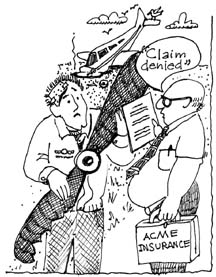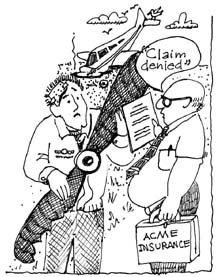
Its every aircraft owners worst double-feature nightmare: First, you crack up your airplane. After surviving in one piece, you jump through all the hoops with the Feds and go home, hoping that tomorrow will be a better day.
Then, you call the insurance company and the adjuster promptly comes to meet you the next day. He requests copies of even more paper than the FAA did, smiles, promises to get back to you and leaves.
Three days later, you receive a letter by registered mail telling you that you failed to comply with the terms of the policy and that the company respectfully declines to pay your claim. The letter concludes by saying that the carrier is aware that you have a choice when purchasing aircraft insurance and hopes that you will think of them if you can ever afford to buy another airplane.
Never Happens, Right?
Does this sort of thing really happen? Absolutely. To get a feel for how often and under what circumstances aircraft insurers deny claims, we spoke to company claims officers, brokers and attorneys who look into coverage questions on behalf of insurers.
What emerges is a fairly rosy picture for the insured who does everything right. In other words, although insurers do deny claims from time to time, its not an everyday event. Nonetheless, there are certain things you can and should do to avoid even the possibility of a claim denial.
If an insurer is considering denying a claim, it usually does its homework first. The carrier will contact an attorney in the applicable state, usually the state where the airplane is based or where the accident happened. That attorney will look into the law of that state as defined by statute law and by similar cases.
Sometimes the carrier will assert that the policyholder breached the contract, or a warranty in the contract. A common example is allowing the airplane to be flown by a pilot who doesnt meet the requirements of the policy.
In other cases, the carrier may feel that there’s simply no coverage for what happened to the airplane. Wear and tear and mechanical breakdown are examples of this.
Either way, if the adjuster thinks there’s a serious coverage problem, he will very likely send out a reservation of rights letter. This letter states that the company is investigating your claim but is reserving its right to deny coverage. In other words, its a stall.
The insurance company will then hire two sets of lawyers: One to defend you against people who are suing you after the accident, and another to find out whether there’s coverage under the terms of your insurance policy.
Varies by State
In some states, the accident must be causally related to the breach of the insurance contract for the company to successfully deny coverage. What does that mean, exactly? It means that the pilot didnt do what he promised the insurance company he would do. But that doesnt always mean what you think.
Say, for example, the pilot breached the contract by forgetting to renew his medical, and the airplane was damaged during a forced landing a week later. Is that causally related? Probably not, but it depends on the state. The pilots lack of a medical didnt precipitate the engine failure that caused the emergency landing.
In some states, however, the mere fact that the aircraft owner breached the contract is grounds for denial, even if the breach is not related to the cause of the accident. That doesnt mean the company will deny the claim, just that they have legal basis to do so.
We didnt expect insurance company people to tell us that they frequently deny the claims of their clients, nor did they. Most of them told us that they look for ways to pay claims, not reject them. Brokers and attorneys told us that some companies look harder than others, but would not comment on who these were.
Many lawyers who do coverage work for aviation companies also work for auto and homeowners insurers. These lawyers seemed to feel that claims handling in aviation is much more liberal than in other areas.
According t0bull, Connecticut, The [aviation insurance] companies generally only litigate the really egregious cases. He cited the example of an Aerostar pilot who was involved in a serious accident following an instrument approach. While the pilot did have an instrument rating, he had not bothered to upgrade it when he got his multi-engine rating. Even that might not have resulted in a claim denial but on his medical application, he checked no next to the question about convictions, despite having served five years in prison for armed robbery. The insurance company had a slam dunk denial-of-claim case and, in fact, didnt pay.
While the vast majority of claims are paid, declinations happen. Here are the areas where most of the action is: The two leading causes of coverage declinations seem to be unqualified pilots and unapproved uses.
After an accident, the adjuster will take a close look at the pilots qualifications and logbook, including recency of experience requirements. Most policies spell out exactly what a pilot needs in order to fly the airplane, including certificates, ratings, total time, time in similar category and class, and time in the same make and model of aircraft.
More and more policies are requiring owners of larger twins to have completed simulator training in the preceding 12 months. If the pilot comes up short in any of these areas, its at least possible that he can find himself without coverage, especially if the shortfall can be linked to the cause of the accident.
Approved uses is another problem area. Most non-commercial light aircraft policies don’t permit the owner to charge for the use of the airplane, although in some cases owners may be reimbursed for some of their costs.
While each policy has slightly different wording, charging for more than fuel, oil and engine allowance may be viewed as rental, thus leaving the owner without coverage. Likewise, an exchange of use of the airplane for services, such as aircraft maintenance or flight instruction may be viewed the same way. All policies also exclude coverage for illegal acts, since to sanction them would be contrary to the public good. But consider the case of a helicopter flight school which rented a Robinson R-22 to one of its students for a solo training flight.
The renter flew the helicopter into the yard of a nearby prison to break out a friend. The landing on the other side of the wall destroyed the helicopter and the two men fled. The insurer took the position that the helicopter was being used for an illegal purpose, and refused to pay the flight schools claim.
Among adjusters we spoke to, about half felt that the insurer was on firm legal ground. The rest said that as long as the flight school had no way of knowing about the students intention, their company would have paid for the claim.
Current Paperwork
Most policies require that an airplanes airworthiness certificate be current and valid, and this is sometimes an area where owners can get into trouble. Suppose you overlook a required inspection and have an accident. If the failure to have the inspection performed is related to the accident, you may find that you don’t have coverage.
Other difficult areas include wear and tear and mechanical breakdown. Wear and tear is a maintenance issue, rather than insurance. Yet, it can take some strange forms. Imagine the fiberglass cowling of an older airplane, with small cracks behind the spinner. Suddenly, it lets go in flight, causing half of the cowling to sail back through the windshield.
According to the policy, the company will pay for the $500 windshield, but not the $3000 cowling, since the cowling wore out, while the windshield was suddenly and accidentally broken.
Yeah, They Pay
With all of these ways to get out of paying, do companies ever pay? Yes, they do. And more often than not. According to attorneys and brokers who don’t have an axe to grind, they frequently go beyond the wording in their contracts. There are good reasons for this, of course. This may be one area where general aviations relatively small size works in its favor.
Several claims officers that we talked to cited situations where they felt obligated to pay a claim that was technically not covered, but where the company felt that denial would give them a bad reputation in the close-knit general aviation community. In other words, the concern was that, long term, denying the claim might damage the bottom line more than paying it.
Another is simply the cost of going to court. According to Jerry Eichenberger, an attorney in Columbus, Ohio who practices aviation law full time, the cost of litigation is so immense that companies are more likely to be flexible about their contracts in small cases. In large cases, especially where people are dead or injured, everybody looks much more carefully at the contract and the law.
Yet a third factor that keeps companies honest is legislation in most states designed to protect insurance buyers from bad-faith claims practices. This is especially true in liability cases. In the course of pre-trial discovery, the plaintiffs attorney will learn that there’s insurance and what the limits of liability coverage are.
In almost all states, if the plaintiff offers to settle within the limits of the policy, the carrier is at great risk if it declines to accept the offer and loses, because the insured may accuse it of bad-faith negotiation, awarding the plaintiff amounts we’ll beyond the policy limits.
So the good news is that declinations don’t happen often. Here are some steps to make sure that you don’t wind up in the middle of one:
Make certain that all pilots who fly your airplane or helicopter either meet the policy requirements or have been specifically approved in writing. Make sure that you have the ratings, training and currency needed when you fly yourself, and that you can document them.
If youre reimbursed in any way for the use of the airplane, either directly or indirectly, make certain that you know how the approved uses section of your policy reads and that you are meeting its terms. If necessary, outline what you would like to do and make sure you have specific approval for it in writing.
don’t lie to the insurance company, especially on applications or other affidavits. If you do, youre better off not buying insurance and putting your money in a high-tech money market fund. Be careful about who you lend your airplane to. If the borrower commits an illegal act with your airplane, you could find yourself without coverage.
Make sure that all the paperwork for your airplane is correct, that all required maintenance has been done and that you can prove it.
While we would like to offer you a bullet-proof recipe for avoiding a disagreement with your insurer, there simply is none. However, there’s one more thing that you can do to tilt the odds further in your favor: Buy insurance from the most reputable broker and company that you can and stay with that company, even if it costs a little more.
Every single claims person we talked to told us that they try to give the benefit of any doubt to customers who have been with them for awhile, rather than people who change every year to save a few bucks.
None of us like to think about it, but if you own and fly an airplane for long enough, you’ll need to file an insurance claim. Our experience suggests that most owners will have some sort of physical damage claim over the course of 10 years of ownership.
You probably wont get hurt, you may not even be there when it happens, but sooner or later, you’ll get your money back.
Also With This Article
Click here to view “Checklist.”
-By Jon Doolittle
Jon Doolittle owns Sutton James Insurance, in Hartford, Connecticut. Hes a regular Aviation Consumer contributor.





